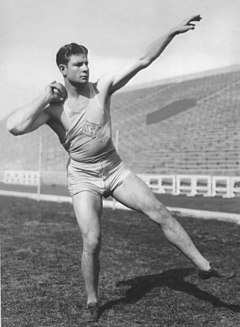Lekkoatletyka na Letnich Igrzyskach Olimpijskich 1932 – dziesięciobój mężczyzn
Dziesięciobój mężczyzn był jedną z konkurencji rozgrywanych podczas X Letnich Igrzysk Olimpijskich. Został rozegrany 5 i 6 sierpnia 1932 roku na stadionie Los Angeles Memorial Coliseum w Los Angeles. Wystąpiło 15 zawodników z 10 krajów.
Rekordy
| Zawodnik | Wynik | Miejsce | Data | |
|---|---|---|---|---|
| Rekord świata | 8255,475[a] (6865)[b] | 19–20 lipca 1930[1] | ||
| Rekord olimpijski | 8053,290[a] (6587)[b] | 3–4 sierpnia 1928[2] |
Terminarz
| Data | Godzina | |
|---|---|---|
| 5 sierpnia 1932 | Bieg na 100 metrów | 10:00 |
| Skok w dal | 11:00 | |
| Pchnięcie kulą | 14:30 | |
| Skok wzwyż | 15:30 | |
| Bieg na 400 metrów | 16:30 | |
| 6 sierpnia 1932 | Bieg na 110 metrów przez płotki | 10:00 |
| Rzut dyskiem | 11:00 | |
| Skok o tyczce | 14:30 | |
| Rzut oszczepem | 16:30 | |
| Bieg na 1500 metrów | 17:30 |
Wyniki
| Poz. | Zawodnik | Reprezentacja | Punkty | 100 m | W dal | Kula | Wzwyż | 400 m | 110 ppł | Dysk | Tyczka | Oszczep | 1500 m | Uwagi |
|---|---|---|---|---|---|---|---|---|---|---|---|---|---|---|
| 1 | James Bausch | 8462,235[a] (6736)[b] | 11,7 s | 6,95 m | 15,32 m | 1,70 m | 54,2 s | 16,2 s | 44,58 m | 4,00 m | 61,91 m | 5:17,0 | ||
| 2 | Akilles Järvinen | 8292,480[a] (6879)[b] | 11,1 s | 7,00 m | 13,11 m | 1,75 m | 50,6 s | 15,7 s | 36,80 m | 3,60 m | 61,00 m | 4:47,0 | ||
| 3 | Wolrad Eberle | 8030,805[a] (6661)[b] | 11,4 s | 6,77 m | 13,22 m | 1,65 m | 50,8 s | 16,7 s | 41,34 m | 3,50 m | 57,49 m | 4:34,4 | ||
| 4 | Wilson Charles | 7985,000[a] (6716)[b] | 11,2 s | 7,24 m | 12,56 m | 1,85 m | 51,2 s | 16,2 s | 38,71 m | 3,40 m | 47,72 m | 4:39,8 | ||
| 5 | Hans-Heinrich Sievert | 7941,075[a] (6515)[b] | 11,4 s | 6,97 m | 14,50 m | 1,78 m | 53,6 s | 16,1 s | 44,54 m | 3,20 m | 53,91 m | 5:18,0 | ||
| 6 | Paavo Yrjölä | 7687,990[a] (6385)[b] | 11,8 s | 6,59 m | 13,68 m | 1,75 m | 52,6 s | 17,0 s | 40,77 m | 3,10 m | 56,12 m | 4:37,4 | ||
| 7 | Clyde Coffman | 7534,410[a] (6265)[b] | 11,3 s | 6,77 m | 11,86 m | 1,70 m | 51,8 s | 17,8 s | 34,40 m | 4,00 m | 48,88 m | 4:48,0 | ||
| 8 | Bob Tisdall | 7327,170[a] (6398)[b] | 11,3 s | 6,60 m | 12,58 m | 1,65 m | 49,0 s | 15,5 s | 33,31 m | 3,20 m | 45,26 m | 4:34,4 | ||
| 9 | Erwin Wegner | 7179,935[a] (6189)[b] | 11,4 s | 6,41 m | 11,70 m | 1,65 m | 51,6 s | 15,4 s | 33,26 m | 3,10 m | 53,83 m | 4:47,8 | ||
| 10. | Péter Bácsalmási | 7001,735[a] (5788)[b] | 12,0 s | 6,71 m | 11,90 m | 1,70 m | 53,8 s | 17,7 s | 41,45 m | 3,50 m | 48,59 m | 5:34,2 | ||
| 11. | Harry Hart | 6799,255[a] (5697)[b] | 11,7 s | 6,14 m | 13,31 m | 1,65 m | 57,2 s | 15,6 s | 40,62 m | 3,10 m | 50,49 m | 5:48,2 | ||
| – | Jānis Dimza | DNF | 11,3 s | 7,22 m | 14,33 m | 1,78 m | 54,8 s | 16,4 s | 40,76 m | 3,50 m | – | – | ||
| – | Zygmunt Siedlecki | DNF | 11,6 s | 6,49 m | 13,56 m | 1,70 m | 53,8 s | 17,0 s | 39,05 m | 3,00 m | – | – | ||
| – | Héctor Berra | DNF | 11,1 s | 7,14 m | – | – | – | – | – | – | – | – | ||
| – | Carlos Woebcken | DNF | DNF | – | – | – | – | – | – | – | – | – |
Uwagi
Przypisy
- ↑ a b Progression of IAAF World Records. 2015 Edition, IAAF, 2015, s. 213, 218 [dostęp 2021-11-18] (ang.).
- ↑ 1928 Summer Games Olympics, Athletics, Decathlon, Men, olympedia.org [dostęp 2021-12-18] (ang.).
- ↑ José María García, Progresión de los Récords de Europa al Aire Libre Progression of the European Outdoor Records (cerrado a / as at 31.10.2016), rfea.es, s. 38 [dostęp 2021-12-18] (hiszp. • ang.).
- ↑ Janusz Waśko, John Brant, Györgyi Csiki, Andrzej Socha: Golden Century of IAAF Records. National Records Evolution 1912-2012. Zamość: 2013, s. 175. ISBN 978-83-62033-30-0. (ang.)
- ↑ Janusz Waśko, John Brant, Györgyi Csiki, Andrzej Socha: Golden Century of IAAF Records. National Records Evolution 1912-2012. Zamość: 2013, s. 180. ISBN 978-83-62033-30-0. (ang.)
Bibliografia
- Olympic Official Reports Collection – Official Reports 1932, s. 456–460 [dostęp 2021-12-18] (ang.).
- 1932 Summer Olympics. Athletics. Decathlon, Men, olympedia.org [dostęp 2021-12-18] (ang.).
Media użyte na tej stronie
Olympic Rings without "rims" (gaps between the rings), As used, eg. in the logos of the 2008 and 2016 Olympics. The colour scheme applied here pertains to the 2016 Olympics in Rio de Janeiro.
Olympic Rings without "rims" (gaps between the rings), As used, eg. in the logos of the 2008 and 2016 Olympics. The colour scheme applied here pertains to the 2016 Olympics in Rio de Janeiro.
An icon that represents a gold medal
US Flag with 48 stars. In use for 47 years from July 4, 1912, to July 3, 1959.
An icon that represents a silver medal
Flaga Finlandii
An icon that represents a bronze medal
Flaga Niemiec o proporcjach 3:2
Sport records icon to be used for world records.
Sport records icon to be used for national records.
Flag of Hungary from 6 November 1915 to 29 November 1918 and from August 1919 until mid/late 1946.
Flag of South Africa, also known as the Oranje-Blanje-Blou, used from 31 maja 1928 until 27 kwietnia 1994
Pictograms of Olympic sports – . This is an unofficial sample picture. Images of official Olympic pictograms for 1948 Summer Olympics and all Summer Olympics since 1964 can be found in corresponding Official Reports.
Sport records icon to be used for European records.
1931 Press Photo Kansas' Jim Bausch wins decathlon at National AAU Meet
Akilles Jarvinen of Finland in action during a running discipline in the Decathlon event at the 1932 Olympic Games in Los Angeles, USA. Jarvinen won the silver medal.


















